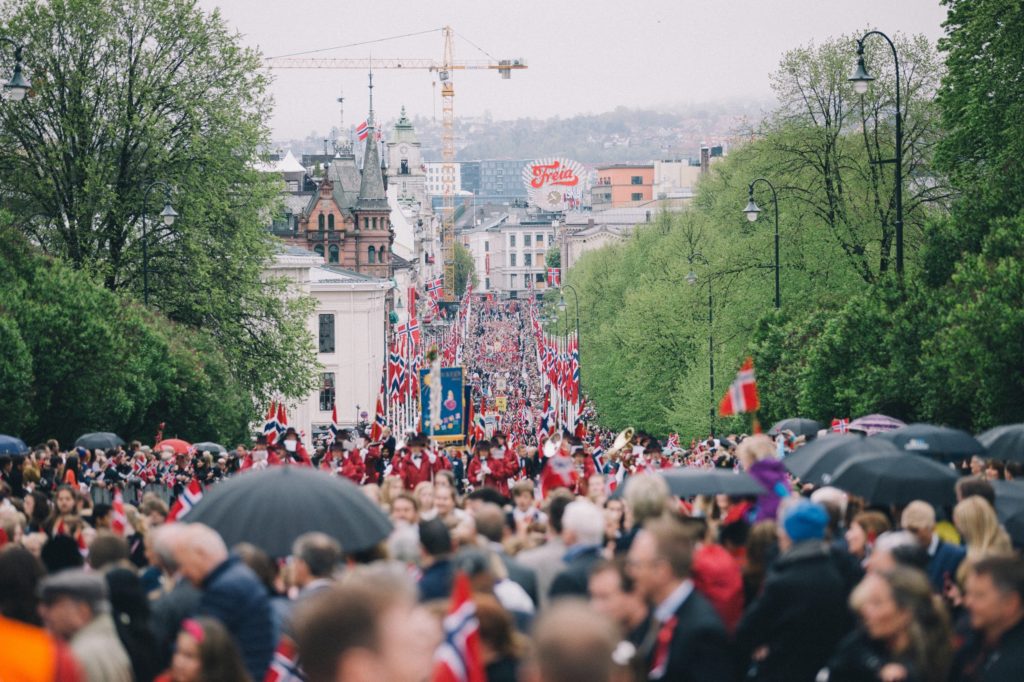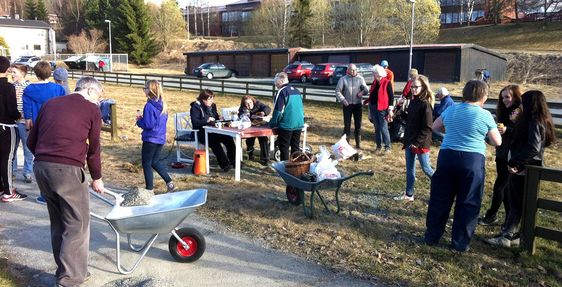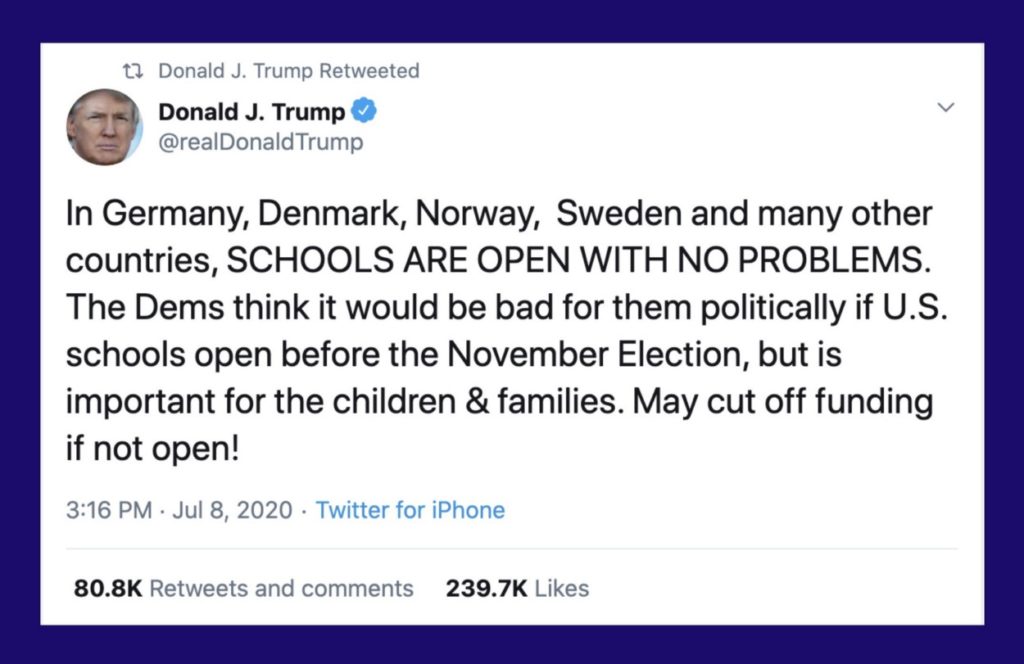And what other countries can learn from its example


I’ve been an American expat in Norway for over eighteen years. And, I have to say, never have I been more relieved to be stuck in my adopted country.
It seems that back home, a select group of individuals has grossly misinterpreted the promises of the American Dream and what it means to possess personal liberties.
You know who I’m referring to; the people in the viral videos you see screaming at and spitting on store clerks when asked to put on a mask. The same people who believe being asked to be considerate of other people’s health is an affront to their freedom.
It’s not hard to believe that there might be a correlation between that me-first attitude and the rising number of confirmed COVID-19 cases in the U.S as record highs are reached every single day.
Meanwhile, in Norway, things have been moving towards the direction of everyday normalcy for a while now. I can safely visit the grocery store, hug my friends, and even enjoy a glass of Pinot Noir at the hot new wine bar downtown. All things that are done mask-free as Norway continues to keep its number of cases low.
And it’s a privilege that I don’t take for granted as I watch my home country from afar struggle to keep its shit together.
With a low number of confirmed cases and COVID-19 related deaths, Norway has managed to achieve what many countries around the world are still striving towards, keeping their people safe.
Just take a look at Norway’s neighboring country and “big brother”, Sweden. Sweden has become the social pariah of Scandinavia as its high percentage of cases and deaths make it difficult to want to welcome them with open arms. For the first time in modern history, Swedes are barred from crossing over the border to their neighbors in the East.
So, what exactly has Norway done to avoid catastrophe and get things back on track? What makes it different from its neighbors, the U.S., or even the rest of the world?
The answer lies in a concept that isn’t exactly unique to Norway but is all the same born from its cultural heritage.
It only took one word to rally the Norwegian people together.
I would reckon that most people have heard of the Amish “barn raising”, where Amish communities have an all/hands-on-deck approach to raising new barns in a short period of time.
Few would recognize the word dugnad if it were brought up in casual conversation, though. It’s a concept that is untranslatable but plenty explainable.
Dugnad (pronounced doog-nahd); a Norwegian cultural tradition where community members work together towards a common goal, for the greater good for all.

Dugnad derives itself from the Old Norse word dugnaðr, which means “help” or “good deed.” It can be traced back to as early as the Viking Age, where villagers would work shoulder to shoulder to their bring ships on to land from the sea after excursions.
And in the 14th and 15th centuries, it was used by rural farming communities to prepare for harsh winters, disease, and other hardships in order to survive together. Everyone had skin in the game; therefore, everyone needed to help out.
The tradition continued into the 20th century as the labor movement gained traction, where social-democratic ideals that valued equality, justice, and a collective “we can do this together” spirit further cemented dugnad into Norwegian cultural DNA.
Ask any Norwegian off the street what “dugnad” means today, and they’ll tell you that it’s usually met with eye rolls and sighs from most people, and optimistic enthusiasm from the Leslie Knope-types with clipboards and binders.
It’s used to gather neighbors in apartment buildings or suburban neighborhoods to rake up leaves in the fall and get ready for winter. Little league soccer teams use it to organize fundraising efforts between parents and athletes by selling hotdogs at games, or Costco sized toilet paper packs door-to-door.
Dugnad is not a one-person job. It’s something done in collaboration with others to create a better life for everyone in the community. And though it can be a pain in the butt to rake leaves with your neighbors on your day off, a sense of civic duty supersedes any annoyance one may hold. It is the Norwegian way, after all: bite your teeth together and get what needs to be done, done.
March 12th, the day Norwegians were called for a national dugnad.

March 12th has now gone down in Norwegian history books as the day that everything changed.
It’s up there with April 9th, 1940, the day when the Nazis made their way up the Oslo fjord starting a five-year-long occupation; or July 22nd, 2011, when a far-right extremist committed an act of terrorism against a government building and a camp for Labor party youth.
But just like those two other turning points in Norwegian history, the people chose to stand together in their fight against this new invisible enemy.
Only hours before the first official COVID-19 death on Norwegian soil, Prime Minister Erna Solberg took the podium on national television. She reminded Norwegians around the country the importance of bearing hardships together as a people:
It has now become absolutely crucial that all of the country’s citizens and residents participate in a national dugnad to slow down the spread.
We are doing this in solidarity with the elderly, chronically ill, and others that are especially vulnerable in developing this serious disease.
We have to protect ourselves in order to protect others. We will stand together through this period in time- not with hugs and handshakes- but by keeping our distance from one another.
It will require a lot from each and every one of us. We need to care about one another and help each other the best we can.
We have gotten ourselves through tough times before- I am absolutely certain that we will achieve this once again.
Daily life came to an immediate halt as schools, offices, gyms, nursing homes, bars, restaurants, and all other public places nationwide were closed with a few hours notice. The weeks following were wrought with fear as Europe became the epicenter of the pandemic. News from devastated Italy and Spain sent chills down people’s spines. Avoiding a similar situation to Italy and Spain became Norway’s number one priority.
Whole industries shut down, and unemployment reached an all-time high with jobless numbers not seen since WWII. The world-renowned welfare system of Norway was put on the spot while it churned out unemployment support to those in need with unprecedented pressure.
Companies, organizations, and cultural institutions were propped up by billion-dollar bailouts as the government tapped into the trillion-dollar commonwealth fund.
People were sacrificing their daily lives and losing out on a lot by participating in the national dugnad. Yet, even while facing hardship not seen since the war, Norwegians stayed a steady course as they all did their part with minimal complaint. The definition of a modern dugnad quickly became synonymous with staying indoors at home, instead of raking leaves with neighbors.
Returning to normal and what other countries stand to learn from Norway.
The official shutdown phase lasted nearly two months, with twice a week briefings and encouragement from the government to keep up the conjoined efforts across the population.
And from May on, things started to resemble the normalcy of pre-COVID times as the shutdown was cautiously lifted bit by bit.
Families and friends were reunited. Gym rats returned to their treadmills. Bars welcomed their faithful patrons back for a round of celebratory drinks. Even the younger kids at elementary schools had the opportunity to return to school for the last few weeks of the academic year.
All because of the collective mobilized effort of 5+ million people.

So, when I saw President Trump’s tweet about Norway and its open schools, I didn’t know whether to cry or to laugh.
As someone who both participated in and witnessed the unified endeavor in Norway, it was almost insulting as it dismissed the hard work that Norwegians put in to get to the point of reopening society.
I can’t help but wonder how differently the present situation in my home country would be, had we had a similar traditional concept such as dugnad in place.
Would we be leading the world in fighting the virus instead of fighting each other over the usages of masks? How could dugnad affect other areas that we struggle in, such as racial and social justice, corruption in both the public and private sectors, and the current political divisiveness across the country?
What the United States and the rest of the world stand to learn from Norway when it comes to handling this global pandemic is this: when a community comes together under the pretense of creating a better reality for themselves and their neighbors, great things happen. And in this case, great things = saved lives.
Norway has not only its people and leadership to thank for succeeding in avoiding a COVID-19 disaster but its historical collectivist mindset where equality and civic engagement is encouraged and valued. It may have taken only one word to rally the Norwegian people in the fight against the pandemic, but it took a deep appreciation of the community to implement it.
You may read the original article at Medium




26 Comments
Pingback: The World's Sustainable Gazette - Bergensia
Pingback: How COVID-19 mRNA Vaccines Work - Bergensia
Pingback: see more
Pingback: Dark web market links
Pingback: Lucky Seven Spirits 6 years old
Pingback: เครื่องซักผ้าฝาหน้า ยี่ห้อไหนดี
Pingback: 토렌트 사이트
Pingback: muay thai bangkok
Pingback: skaties te
Pingback: Bergensia just passed a 1000 articles - Bergensia
Pingback: บำรุงรักษาระบบไฟฟ้า
Pingback: Arcade Game
Pingback: 웹툰 무빙 무료보기
Pingback: 1688upx
Pingback: ให้เช่าคอนโด
Pingback: hair queen
Pingback: bergara premier approach
Pingback: panama888 คาสิโนออนไลน์ ฝากเงินขั้นต่ำ10บาท
Pingback: Winchester Deer Season Extreme Slug Ammunition 12 Gauge 2-3/4" 1-1/4 oz Slug For Sale Online
Pingback: ขายฝากที่ดิน
Pingback: resource
Pingback: โคมไฟ
Pingback: รับพิมพ์สติ๊กเกอร์
Pingback: บุหรี่นอกเก็บเงินปลายทาง
Pingback: ฟิล์มกรองแสง
Pingback: 80 mg di ossicodone da acquistare online